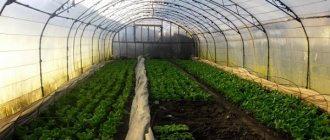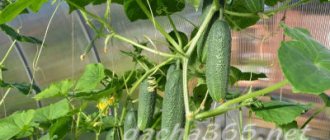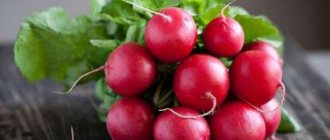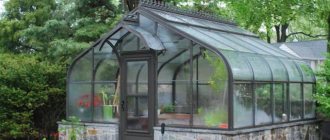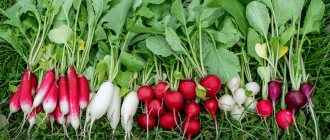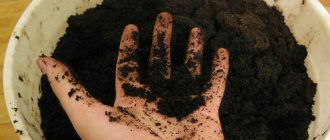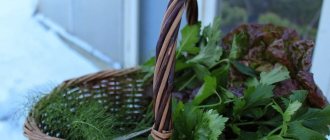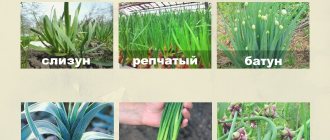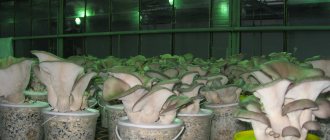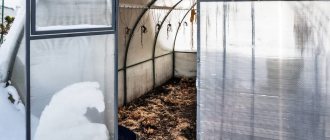Purple basil: with what, then can you plant it in the beds in the garden?
Basil is known for its spicy aroma. Its leaves perfectly complement various meat dishes, salads, and sauces. In addition, the basil plant is often used in landscape compositions; the beautiful rich purple color of basil will become a decoration for flower beds. But they still love basil for its taste and aroma.
Among the varieties of purple basil are:
- Ararat
- Yerevan
- Pepper aroma
- Opal
- Vanilla
- Thai
Basil is sold in supermarkets, markets, and vegetable stalls; purchasing the spice is not a problem. But you can grow this plant at home if you know some of the subtleties of care. Basil is capricious. Sufficient lighting, suitable soil, and fertilizer are required. Without proper care, instead of abundant large leaves, you can get limp greens. Therefore, let's figure out what conditions need to be organized for growing an annual basil plant.
Purple basil
First you need to choose the right place to plant your seeds or seedlings.
Important: According to the rules for alternating crops in open ground, basil cannot be planted in one place for more than 5 years. If you do not adhere to this rule, a massive disease of all nearby plants with fusarium is possible.
Good neighbors for basil will be:
- Legumes. Basil prevents bean weevil from infecting legumes.
- Tomatoes. Fragrant basil has a positive effect on the taste of tomatoes.
- Bell pepper. Basil has a positive effect on the growth and development of sweet peppers.
Basil can be planted after potatoes and tomatoes. For a good harvest of these crops, fertilizers are usually used, which subsequently have a positive effect on the growth of basil.
Basil is often planted in the tree trunks. Basil drives away pests with its smell and phytoncides. Only trees need to be selected with a small crown so that the basil receives a lot of light.
Bad neighbors for basil are daikon and radish.
Neighborhood of crops in the garden
Variety selection
Today there are about 150 types of basil, differing in color, leaf size, and plant growth. Beginner gardeners are advised to choose proven, undemanding varieties. If desired, you can simultaneously plant several varieties of greenery in one greenhouse.
Yerevan
An annual plant with a spicy taste and a rich content of essential oils, vitamins and carotene. From the moment of sowing until the plant is ready for harvest, an average of 45 days pass. This variety of basil has red-purple leaves. The weight of one shoot varies from 300 to 500 grams. The aroma of the herb contains a hint of tea and allspice. Greens can be used fresh or as a seasoning for various dishes. The plant is often used by landscape designers.
Spoon-shaped
Basil gets its name from the shape of its leaves, which are concave inward and resemble a spoon in appearance. The plant has light green, oblong-shaped leaf blades without teeth. When flowering, white inflorescences are formed. The taste of basil is reminiscent of cloves and bay leaves, so I often replace such seasonings with it when cooking. The spoon-shaped variety is used for stewing and cooking meat dishes; it perfectly complements the taste of tomato.
Baku
The variety was first grown in Azerbaijan. Externally, the shape of the leaves resembles Yerevan basil, but the color of this basil is brownish-purple and therefore it is often called “black”. The greens have an aroma of a mixture of mint and clove notes. The plant is most often used as a seasoning in spicy oriental dishes.
How to prepare basil seeds for sowing in a greenhouse, hotbed, or open ground?
Purple basil can be grown from seeds. It is advisable to plant the plant in open ground in seedlings. The seeds must first be planted in pots; after germination, the seedlings are planted in the garden.
Important: Successful germination of basil largely depends on proper seed preparation. Basil seeds have an ethereal coating, which makes it difficult for the seeds to germinate.
The seeds of some vegetables are soaked before planting for better germination. Basil seeds do not need to be soaked; they need to be warmed. It is recommended to keep the seeds in a well-warmed place for two weeks before planting in the soil. Heating batteries are suitable for this. Place the seeds in a natural fabric bag, then place them on the radiator.
Immediately before planting in the soil, basil seeds are placed in a solution of potassium permanganate for a couple of hours. Many summer residents water the soil with the same solution before planting seedlings. This helps to disinfect the soil and protect the seeds from various pests.
Purple Basil Seeds
Preparing the soil for planting seedlings
The soil for growing basil should be loose. The plant grows well in light, permeable soils. You can prepare the soil for sowing seeds yourself or buy a ready-made universal mixture for vegetable seedlings.
The soil for sowing basil seeds is made from garden soil enriched with peat and humus. Another soil mixture consisting of 1 part river sand, 2 parts humus or compost and 4 parts peat is also suitable for growing plants.
What kind of soil does purple basil need?
Basil requires suitable soil. You should not expect a good basil harvest on wet, heavy clay, loamy soils. The soil should be loose.
It is recommended to dig up the soil before planting basil, as well as in the fall. The following fertilizers must be applied per 1m2 of soil:
- Humus - from 3 to 5 kg;
- Superphosphate - 25 g;
- Potassium salt - 15 gr.
If you plan to grow a plant on clay soils, you must first thoroughly break the soil with a hoe or hoe. But, as practice shows, on such soils basil often gets sick and grows weak.
Choose a sunny place for basil so that the sun warms the plant throughout the day. Drafts should also be avoided.
The soil from the garden needs to be disinfected before planting seeds in pots. To do this, the soil is first sifted and then steamed in a water bath for 1 hour. This will protect the seeds from fungal diseases. Soil purchased in a store undergoes the necessary processing.
Soil for basil
Useful properties and contraindications
In various types of culture, the content of oils rich in beneficial substances (cineole, camphor, ocimene, saponins, methyl chavicol, vitamins of groups B, PP, A, C) is 1.5-2%. Essential oils, jasmine and arachidonic acids, which have anti-inflammatory and antioxidant properties, collectively play the role of natural antibiotics and hepatoprotectors. These components are added to medications intended to treat diseases of the respiratory system and liver. Extracts and extracts are successfully used in cosmetology.
Fragrant leaves add a Mediterranean flavor to even the simplest dishes.
In addition to its beneficial properties, fragrant herb also has a number of contraindications: it has an irritating effect on the gastrointestinal tract. Gastroenterologists do not recommend consuming it in large quantities, since plants are capable of accumulating compounds of mercury salts and heavy metals. Although the degree of contamination with heavy metals is largely a matter of growing conditions, environmental conditions, place and time of collection of raw materials. That is why many gardeners prefer to cultivate vegetable greens on their own plot, rather than buying them at the market or in a store.
Purple basil - growing from seeds: when to sow seeds in a greenhouse, greenhouse, open ground?
Basil bushes grow well in a greenhouse or greenhouse. Basil grows worse on a windowsill.
You can grow purple basil in greenhouse conditions all year round; in order for the seeds to germinate, you must constantly maintain the temperature at +25°C.
If you plan to plant seedlings in open ground, the seeds must be planted in pots 2 months before planting. The seed planting period is March and early April. Seedlings can be planted in open ground only in June, when 24-hour warm weather sets in. Basil does not tolerate frost at all.
Growing basil from seeds
Planting seedlings in early summer will ensure an early harvest of purple basil. Gradually, you can sow seeds into open ground, which will allow you to harvest throughout the summer season. If you plant not seedlings, but seeds in open ground in June, you will be able to harvest a late August harvest.
Basil grows well in a greenhouse. If you plan to plant seedlings from a greenhouse into open ground, you should harden off the seedlings. To do this, a week before planting in open ground, pots with young plants are practically not watered, the greenhouse is ventilated daily and the temperature is reduced. This method will ensure the survival of seedlings in open ground.
Seeds should not be buried more than 1 cm into the soil. At the same time, you should regularly ensure that the seeds are not dislodged from the soil as a result of watering. It is recommended to keep the seeds covered until the first shoots. After the sprouts appear, the film can be removed.
Important: If you want to sow different varieties of purple basil, be sure to label each variety. This will allow you to determine the one that is most suitable in taste and most adapted to your conditions.
It is recommended to plant seeds densely, as not all will sprout. Subsequently, the seedlings will need to be thinned out. Picking seedlings into separate pots is possible when 1-2 leaves appear on the sprout.
Greenhouse and soil requirements
Before planting, the greenhouse should be properly equipped. In case of early planting of crops, it is better to use glass as a covering for the greenhouse. Its use allows you to protect greens from frost and maintain a stable microclimate in which there will be no temperature changes.
A cushion of soil will protect the seedlings from freezing. Such care allows you to reduce water consumption for irrigation. The greenhouse will need to be equipped with vents.
It is better to build a greenhouse on a piece of land that receives good sunlight. The soil should be loose and moderately acidic. You can improve soil properties with the help of fertilizers. The use of peat, soil and sand is considered an inexpensive and practical option. It needs to be used to fill the beds after first removing 20-25 centimeters of soil.
You can also simply dig up a piece of land to a level of 30 centimeters. Then everything is distributed throughout the site.
How many days does it take for basil to sprout after sowing?
Important: At a temperature of +25°+27°, purple basil seeds will sprout in 10-12 days.
Shoots may appear earlier, 7-8 days after planting. But this is a rare case.
If the shoots do not appear at the specified time, do not rush to panic, you should wait some more time. Perhaps the temperature is not favorable enough for seed germination. Place the container with the seeds in a warmer place.
Rapid seed germination depends on soil moisture. Create a greenhouse effect by covering the container with film. The soil should not be dry or too wet.
Purple basil in the garden
When planting seedlings, distance should be maintained. The optimal distance between rows is 25-30 cm. Between individual basil bushes, the permissible distance is at least 25 cm. Basil bushes can reach 50 cm in height; they need space for abundant growth. Densely planted basil grows small-leaved and weak.
Important: Plant seedlings in open ground in the evening, in calm weather.
Harvesting
As soon as the shoots reach 12 centimeters, they are cut off. This should be done over the 3rd pair of leaves. Their oriented height is 7-8 centimeters from the soil level. The soil between the rows will need to be loosened. Fertilizers are also added to it. After 20 days, the greens will grow to the desired size, after which they will need to be cut again. Each basil bush allows you to harvest up to 4 times.
You need to harvest before the leaves become rough. To dry greens, they should be picked in warm, dry weather.
How often to water basil in a greenhouse, hotbed, or open ground?
Purple basil, like other varieties of the plant, needs constant watering. However, it is unacceptable for water to stagnate. The soil must be well drained. Overmoistening of the soil is fraught with the disease “blackleg”. Dry soil will result in low yield.
Rules for watering basil:
- Make sure the soil is moist, but do not flood it under any circumstances.
- Water at the root of the plant.
- Water carefully, being careful not to wash the roots of the plant with water.
- Water for irrigation must be warm and settled.
- Basil should be watered in the morning so that the plant is saturated with water during the day and the moisture evaporates.
The weather is changeable; in the hot season, daily watering is required. On cloudy days, watering is not always required. The main rule for watering basil is that the soil should always be slightly moist.
Caring for basil involves frequent loosening of the soil. It is convenient to do this after watering.
Watering basil
How to feed basil in a greenhouse, hotbed, or open ground?
Important: Feeding is one of the important conditions, without which it is difficult to get a rich basil harvest.
Basil should be fed at different stages of growth:
- The first fertilizing is carried out during planting. If seeds are planted in open ground, it is appropriate to use the Zircon growth stimulator.
- In a greenhouse, the first fertilizing is required with the appearance of the first leaf. This feeding is especially important if the seedlings are not growing well. For feeding, potassium (3 g), nitrogen (2 g) and phosphorus (5 g) fertilizers are diluted in 1 liter of water. This solution should be watered over the plants.
- If you did not fertilize the seedlings at the stage of growing them in pots, be sure to fertilize them 2 weeks after planting the plants in open ground. In this case, the complex mineral fertilizer nitrophoska is well suited.
- In the future, feeding is required once a month. Basil needs nitrogen fertilizers, which stimulate the growth of green mass.
Care, watering and fertilizing
Care consists of timely watering, loosening and removing weeds. Moisture should be moderate, otherwise the plant will suffer from black stalk. It is necessary to remove the inflorescences in a timely manner, in this case the basil will form new shoots.
The plant is fed once every 14 days, using nitrogen-phosphorus-potassium fertilizers. To prepare a nutrient solution, it is recommended to carefully read the instructions for the drug. In most cases, the product is diluted in proportions of 10 grams per 1 liter of water. Nitrogen has a stimulating effect on basil and causes it to form more greenery. Potassium and phosphorus contribute to better production of essential oils.
Do I need to pinch purple basil?
Important: Purple basil must be pinched. This will ensure proper growth and beautiful formation of the bush.
Pinching is the procedure for removing the apical shoot. This is done quickly and does not require special skills. The benefits of pinching are great. This procedure allows the plant to grow side shoots and a mass of leaves. If you do not remove the apical shoot, the basil will grow upward and there will be few spicy leaves, which are the main target. Pinching will ensure greater yield.
In addition to pinching the top, you need to get rid of the flower stalks. Removing flower stalks will ensure the appearance of new shoots.
Purple basil: diseases and pests
Important: Basil is a disease-resistant plant. But if the growing conditions are not met, the plant is affected by fungal diseases.
Knowing the causes of diseases and pests of basil, you can prevent plant damage.
Diseases of purple basil:
- Blackleg is a fungal infection of the root collar and stem of a plant. It is not difficult to identify this disease; the stem becomes dark and the leaves become depleted. Blackleg damage is caused by excessive watering, poor drainage, poor aeration and increased soil acidity.
- Gray mold is a fungal disease that mainly affects basil in a greenhouse. This type of fungus is present in the soil, but actively begins to multiply due to an excess of moisture in the air. As a result of high temperature and moisture, drops form on the leaves, which lead to the death of the leaves. First, gray dry spots appear on the leaves, then they become watery and fluff appears. The fungus spreads to all parts of the plant and leads to death.
- Fusarium - characterized by wilting of the plant. On young plants, the disease manifests itself as depletion of the stem, the color becomes brown. Adult plants begin to die from the top, it dries out. Fusarium affects seeds and can be present in the soil. For prevention, it is recommended to regularly alternate the planting site for basil.
Basil diseases
Pests practically do not bother basil. Moreover, this plant serves to repel various pests, such as aphids, spider mites, and field bugs. Sometimes the plant is affected by Japanese beetle. You can get rid of the pest manually by collecting the insect.
The best prevention of diseases is disinfection of the soil before planting, proper watering, and sufficient air in the greenhouse. In the early stages of a fungal disease, spraying with an infusion of onion peels helps. It is important to get rid of diseased plants so as not to expose other basil bushes to the disease.
Advantages of greenhouses
By growing basil in unheated greenhouses, it is possible to obtain early harvests. To speed up the ripening of greens, the seedling method is used. Around April, the grown seedlings are planted under film.
Advantages of growing basil in an unheated greenhouse:
- under covering material, the crop grows faster;
- under the film the greens are protected from sudden temperature changes;
- better protection from pests;
- higher yields;
- the condition of the plants does not depend on weather conditions.
Advantages of growing in a heated greenhouse:
- getting greens all year round;
- grown basil and other greens can be sold profitably; prices are highest in winter.
On a note! Basil in a greenhouse can coexist with other crops. The best neighbors for it are nightshade crops - eggplants and tomatoes.
Why purple basil does not sprout or sprouts poorly: reasons, what to do?
There may be several reasons why basil does not sprout. Often seeds do not germinate for several reasons:
- Poor quality seeds. Unfortunately, this is not at all uncommon. It is worth buying several bags from different manufacturers at once.
- Cold weather. Basil is a heat-loving plant; the seeds germinate only at a favorable temperature of at least +25°.
- Lack of light. This is a very important factor for seed germination.
- Bad soil. Basil will not grow in heavy loamy soil.
- Lack of moisture. If you constantly forget about watering, you should not expect good results.
Important: If you have fulfilled all the requirements for planting seeds and further care, but the basil still does not sprout, wait a little. Typically, seedlings appear on days 10-12, but if there is a lack of heat or moisture, the seeds may sprout later. Many summer residents noted that the seeds sprouted even in the third month after planting.
Try to analyze what your seeds lack for successful germination. It may be worth adjusting the irrigation system, or ensuring a suitable temperature.
Basil has a better chance of sprouting when the seeds are covered with film when planting. Especially if they are planted in open ground. Make a mini greenhouse for basil seeds.
If you think that all the conditions have been met, but there are still no shoots, use growth stimulants.
Important: The success of seed germination also largely depends on the proper preparation of raw materials for planting.
Basil shoots
The most common varieties for temperate climates
As you know, basil has tropical “roots”, so many varieties and varieties simply do not take root in open ground. They can freeze out, dry out in unfavorable weather conditions, or simply develop very slowly with a lack of sunlight. But these problems were largely solved thanks to the efforts of domestic breeding stations, which acclimatized the annual grass. Modern varieties allow every summer resident to grow spices on their own plot without special care. Let's look at the most popular varieties of basil, which have already proven themselves well in the temperate climate zone.
- Anisic. A high-quality hybrid from the Krasnodar breeding station, acclimatized for cultivation in the southern regions of the Russian Federation, Poland and Moldova. Grows at temperatures from +2 to +30 degrees, the leaves are very small. Thanks to its unusual taste (somewhat reminiscent of anise with apple flavor), it has become very popular. It has several flavors that change during its preparation. The inflorescences have a bright red color, so it is often planted on the site as an ornamental grass. With good watering, it can produce up to 4 kg of green mass per square meter.
- Moulin rouge. One of the most famous ornamental varieties. It is often planted instead of flowers in flower beds, since the color of most of them simply cannot compare with the appearance of blooming basil. Cross-pollination allows you to get all the colors of the rainbow in your area, and this beauty can also be used as a very fragrant spice for dishes. The leaves have an extremely strong smell and taste, reminiscent of a mixture of anise and apricot. It is recommended to use Moulin Rouge as a seasoning for beef or rice. With good care, you can collect up to 3 kg of greenery from 1 square meter. The stems can reach 70 centimeters in height.
- Minimum. An exclusively culinary crop, which is used as a seasoning for many dishes and an ingredient for preparing healthy salads. The peculiarity of this plant is its small size - only 12-16 centimeters in height. Suitable for growing on balconies, since the root system does not require a lot of free space for high-quality rooting and sucking nutrients from the soil. The yield is high, from 1 square meter you can collect up to 5 kg of greenery per season, the main thing is to periodically mow the mass so that new leaves grow.
- Thai Queen. A unique variety of its kind, which has a very strong aroma and sharp taste, which is why many gardeners liked it. It has unusual inflorescences, very similar to lilac clusters. Used in cooking and also as an ornamental plant. Requires constant watering, only then will the leaves have the desired taste, and the yield will be at least 3 kg per 1 sq. m.
The choice of the right variety depends only on the personal wishes of each cook. Some prefer a “softer” taste and smell, while others prefer sharp basil. If you are going to grow it on a windowsill, then it is best to choose short grass - it is easier to care for.
Why does purple basil turn green: reasons, what to do?
Summer residents are often concerned with the question: why does purple basil turn green? Such a case is by no means uncommon. Many people think that the seeds were of poor quality. But it happens that purple entrances appear first, and then turn green.
This happens when there is insufficient sunlight. Basil should be in the sun 6-8 hours a day. If the weather is cloudy outside or the basil is growing on a windowsill in the shade, the leaves and tops of the plant begin to turn green.
There is no need to get rid of such a plant, everything is fine with it. It is enough to take the basil to a sunny place, and the leaves will again acquire a purple tint. If it is not possible to provide sunlight, it is recommended to install lamps for artificial lighting in greenhouses and on window sills.
If basil is growing in the garden and has begun to turn green, wait for sunny days. You will see your basil bushes begin to change color.
Basil turns green
Why do the leaves of purple basil turn black in the garden beds: reasons, what to do?
Important: If the leaves of the basil turn black, this indicates that the plant is infected with the fungal disease “blackleg”.
Your actions as a result of the formation of black leaves may be as follows:
- Review the irrigation system. Most often, the cause of the development of the disease lies in abundant watering.
- Loosen the soil. Creating soil that drains well will help save the situation.
- Getting rid of weeds. Regular weeding of basil is required. Weeds inhibit the growth and development of plants.
- Removing affected leaves and plants. If your entire basil bush turns black, get rid of it. Remove blackened leaves.
- Tilling the land with potassium permanganate. After uprooting the diseased plant, the earthen lump located under it is removed.
- A plot of land is watered with a solution of potassium permanganate.
These simple steps will help you save your basil harvest at the early stage of the disease. But if the disease has taken hold, fungicides will help to cope with it.
Preparations for processing basil:
- Fundazol
- Topaz
- Fitosporin
After the final harvest, the land will need to be additionally disinfected with a solution of potassium permanganate and dug up. Next year the basil should be planted in a different place.
Growing methods step by step
In a greenhouse, basil can be grown from seeds or seedlings. The first method simplifies the growing process and is used mainly in heated greenhouses. Planting seedlings is popular when grown in unheated film greenhouses.
Basil seeds take a long time to germinate and are not very vital, so it is recommended to soak them in a growth enhancer before sowing, and at the same time disinfect them. Basil sowing order:
- Make small grooves in the leveled soil, no more than 2 cm deep. Place seeds in them at intervals of 15 cm. The distance between adjacent grooves is 30 cm.
- Basil seeds can germinate deep, so do not bury them too deep. It is enough to cover them with a thin layer of earth.
- To get a year-round harvest in heated greenhouses, re-sow once every three weeks.
In the Russian climate, it is customary to grow basil in greenhouses in order to obtain an earlier harvest. To speed up the growing season, basil is planted as seedlings in greenhouses.
Basil is sown for seedlings in early April. The procedure for growing basil using the seedling method:
- To grow seedlings, prepare containers of small depth - 5 cm is enough. Be sure to line their bottom with a layer of drainage.
- Fill them with soil. If there is no purchased substrate, prepare a soil mixture of humus, peat and sand (2:4:1). Before filling the containers, douse the soil with boiling water and a pink solution of potassium permanganate.
- Spread the seeds evenly over the surface, and then sprinkle them with a layer of soil. Deepen them by 0.5-1 cm.
- Maintain the temperature in the room where the containers with seedlings are located at a level of +20 to 25 °C. After about 10 days, shoots will appear. Immediately after they appear, lower the temperature to +18...+20°C. This will prevent the seedlings from stretching and lodging. If daylight hours are less than 12 hours, turn on the phytolamps.
- Water the seedlings with warm, settled water so often that the soil is always slightly moist. Basil does not tolerate drying out. However, stagnation of water is unacceptable - rotting may begin, and seedlings risk contracting a dangerous fungal disease - blackleg.
- After 14 days, feed the seedlings with a mixture of fertilizers. Prepare it by mixing 4 g of superphosphate and wood ash, and add 2 g of ammonium nitrate.
- When the seedlings have 2 true leaves, pick. To do this, plant the seedlings in separate glasses.
On a note!
To help your basil bushes produce more green mass, pinch the tops of the seedlings when they have five leaves.
Why does basil turn purple: reasons, what to do?
Important: Basil flowering is a natural process. Flowering occurs 2-3 months after planting the seeds.
A tassel with white, pink or white-violet flowers appears at the top of the stem. The flowering of basil coincides with the harvest. If you are growing basil for food, cut off the flower heads.
The tassels of the inflorescences need to be cut off along with the two lower leaves. If you don't cut the flowers, the leaves will become hard. Flowering also affects the taste of basil. During the flowering period, basil leaves accumulate a large amount of essential oils, which makes the leaves more fragrant.
You can avoid cutting off the inflorescences in the following cases:
- If you want to collect seeds for planting next year.
- If you are growing basil as an ornamental plant.
Basil flowers are used for medicinal purposes. Based on them, tinctures and decoctions are made for healing small cuts, wounds, and for treating problem skin.
Basil blossom
Business idea for growing basil and mint with calculations
How to start a business growing mint and basil in a greenhouse? What other growing options are there, and is it worth combining ideas? How to build a quality greenhouse? Read the business plan for growing mint and basil in a greenhouse all year round with calculations.
Growing basil and mint as a business in a greenhouse.
Business plan for growing basil and mint
| Investments: 550,000 rubles | Income: 406,800 rubles |
| Quantity: 120 square meters | Payback: 3 years |
Basil and mint are healthy herbs that are grown both for personal use and for sale as a business. It is difficult to grow high-quality greens in large quantities in open ground, so entrepreneurs prefer growing them in greenhouses to increase their earnings. And to make a profit, year-round greenhouses are built all year round.
Evaluating the idea
Growing greens in a winter greenhouse is a process with a lot of nuances, so the matter requires evaluation. Answer the questions to understand the mint and basil business:
- Where to grow basil and mint? – it is better to grow in a year-round greenhouse; business will be most profitable there.
- Who will do the growing? – you can grow it in large quantities yourself, the main thing is to establish the technology for growing and marketing.
- What else can you grow with mint and basil? – combined ideas, but you can choose one or combine it with growing other greens.
- What is the demand for mint and basil in your region? – the volume of cultivation depends on demand. If the demand is not high, combine ideas.
- Are there competitors in the market? – It’s worth paying attention to your competitors.
If the choice fell only on these two plants, then start studying growing technology. Also look at the pros and cons of the case.
Pros:
- Quality mint is in short supply.
- You can start by growing in an apartment.
- In a greenhouse, the weather will not affect the yields.
- By controlling conditions, yields are higher.
Minuses:
- Expensive construction of a greenhouse business.
There are also risks in the case - loss of harvest, problems with sales and other risks. But they are inherent in any growing business.
Construction of a winter greenhouse with equipment
For business, we will build a year-round greenhouse of 120 square meters. You can install it yourself or hire workers. We will not count labor in our calculations.
All costs were calculated using a construction calculator using average market prices.
Costs for constructing a greenhouse:
- 7,000 rubles for a pit and a trench for the foundation;
- 53,000 rubles for a reinforced strip foundation;
- 45,000 rubles for a metal frame made of profile pipe;
- 85,000 rubles for polycarbonate cladding.
The total cost of the greenhouse will be 190,000 rubles. Next, shelving and all the necessary equipment are installed in the greenhouse. Below is a list of equipment costs for a winter greenhouse.
An alternative to a greenhouse is to grow mint and basil in an apartment.
Greenhouse equipment costs:
- 80,000 rubles for three-tier racks;
- 50,000 rubles for infrared heaters;
- 75,000 rubles for a well and drip irrigation installation;
- 25,000 rubles for lighting with metal halide lamps;
- 10,000 rubles for payment for equipment installation services.
The equipment and installation will cost 240,000 rubles. Ventilation can be done with vents. There will also be costs for working tools - 10,000 rubles. Decorating a greenhouse will cost 10,000 rubles. Other miscellaneous investments in the greenhouse are another 20,000 rubles.
Investments in a year-round greenhouse with equipment will amount to 470,000 rubles.
Basil growing technology
You can plant 20 plants per 1 square meter. The total area for planting basil will take 120 square meters - 3 tiers per half of the greenhouse. On average, it takes 2 months to grow basil, which means there will be 6 plantings per year. Every year you need 20 * 120 * 6 = 14,400 seeds or 23 grams. The cost of 1 gram is 6.5 rubles. The cost will be 150 rubles.
The most popular varieties of basil: Yerevan, Spoon-shaped, Baku.
The soil should consist of soil, peat and sand. Basil is planted by scattering the seeds over the surface of the soil in a pattern of 18 x 18 centimeters, then covering it with soil. The optimal temperature for growing basil is from +20 °C to +25 °C.
Basil care:
- Loosening the soil;
- Weed removal;
- Moderate watering;
- Disease prevention;
- Fertilizing with mineral fertilizers.
By the end of the second month after planting, you will have harvested the entire crop and planted new seeds.
Annual maintenance of 60 square meters of greenhouse: seeds 150 rubles, fertilizing 5,000 rubles, soil replacement 15,000 rubles, electricity 45,000 rubles, packaging 3,000 rubles.
Mint growing technology
You can plant 60 pieces of mint per 1 square meter. The total planting area is 120 square meters. It takes an average of 4 months to grow mint. There will be absolutely 3 plantings per year. In total, you need 60 * 120 * 3 = 21,600 mint seeds per year or 1.5 grams. The cost of 1 gram is 100 rubles. You need 150 rubles a year for seeds.
Mint is demanding on moisture. The humidity in the greenhouse should be between 60-70%. Temperature ranges from +18 °C to +21 °C.
It can be grown either hydroponically or in soil. We will look at growing in soil. The soil can be mixed with coconut briquettes, which will increase yields. The soil itself consists of sand, peat and perlite.
- Loosening the soil;
- Constant watering;
- Weed removal;
- Treatment against pests and diseases;
- Fertilizing the soil with mineral fertilizers.
Mint is easy to grow, but drying out the soil will lead to the death of the plant. Mint harvesting begins 3 months after planting.
Annual investment in seeds is 150 rubles, fertilizing is 5,000 rubles, soil replacement is 15,000 rubles, electricity is 45,000 rubles, packaging is 3,000 rubles.
Sales of basil and mint, business registration
Build your business based on demand. If demand is low, plant so that you receive a fresh batch of greens every 1-2 weeks.
How, where and where to sell basil and mint:
- On the market;
- Resellers;
- Cafes, restaurants;
- Word of mouth;
- Grocery stores;
- Advertising in a local newspaper;
- Supermarkets, hypermarkets;
- On message boards and social networks.
You can register a business as a private subsidiary or individual entrepreneur. Taxes will be within 6% of declared income. For official sales, you will have to seriously engage in product certification and comply with the stated standards.
Annual costs for advertising and fuels and lubricants are 25,000 rubles. Registering a case costs 5,000 rubles. Annual tax payment is 35,000 rubles.
Expenses and income - counting profit
Cost chart for starting a business:
| № | Name | Amount in rubles |
| 1 | Year-round greenhouse | 470 000 |
| 2 | Registration | 5 000 |
| 3 | Other costs | 20 000 |
| Total: | 495 000 |
How and when should you collect basil seeds?
When basil is in bloom, you can collect seeds for planting next season.
Important: Seeds can be collected when the inflorescences become dry and brown. This indicates that they are mature. If you collect raw seeds, they may not sprout.
Seed collection should be done in dry weather. It is difficult to name a specific date for collecting seeds; basil bushes can bloom at different times. Plants must be inspected regularly after flower stalks appear. It is important not to miss the moment and prevent the seeds from falling to the ground.
Collect basil seeds as follows:
- Cut off dry inflorescences.
- Place them in a ventilated, dry place for final ripening.
- The inflorescences should be threshed and debris removed.
- Place the seeds in paper bags or fabric bags.
- Seeds must be stored in a dry place at room temperature. When properly stored, seeds can retain their properties for up to 5 years.
Important: Do not store seeds in plastic bags, they may be banned.
How and when to harvest basil for drying, preparations for the winter?
You can cut basil leaves for food from the moment the bushes reach a height of 12-15 cm. It is advisable to cut the leaves from the top of the shoot. This will ensure the appearance of new young shoots. This method will help achieve bushiness and growth of leaf mass.
Spicy basil should be harvested at the end of July, in August. Harvesting is carried out in dry, windless weather. Only the leaves should be cut off, leaving the stem as new leaves may appear on it. After the main harvest, you should not expect a rich growth of green mass by the plant, but for everyday culinary needs such reserves may be quite sufficient.
Important: Strong plants can be dug up and planted in a pot when cold weather sets in. For some time it will be possible to collect fresh basil leaves indoors.
The collected basil leaves should be stored for the winter. To do this, they should be dried in the shade. Store dried leaves in an airtight container, this will ensure their aroma for a long time.
Drying basil
What to plant after basil in the beds?
Basil bushes should be dug up in the fall. In warm regions in September you can still collect the remains of fresh leaves. If you live in a region where autumn begins according to the calendar, dig up the bushes earlier.
Plant remains should be disposed of and the bed should be dug up. In the fall, you can apply organic fertilizers. This will ensure soil fertility next season. After basil, it is good to plant crops:
- Onion
- Potato
- Tomatoes
- Zucchini
- pumpkin
- cucumbers
- Garlic
Neutral followers of basil are:
- Corn
- Beet
- Eggplant
Caring for purple basil will not be difficult even for novice gardeners. It is much more difficult to organize the necessary conditions for plant growth. But now you know how to do it. Many people who have discovered the taste of basil never part with it. If you haven't yet found a use for this aromatic herb, be sure to give it a try. In addition to its taste, the value of basil lies in its range of health-promoting vitamins. We invite you to watch a video on how to properly prepare basil for the winter.
Compatibility with other crops
Basil gets along well with most herbs and vegetable crops, but it is still better to plant it with eggplants and tomatoes, but cabbage, marjoram, radishes, radishes and dill are undesirable neighbors.
Experienced gardeners believe that the best predecessors for basil are:
- tomatoes;
- potato;
- legumes.
Important!
Basil grows well after cucumbers, since high-quality organic matter is always added to them, but as neighbors in beds in the same greenhouse, cucumbers are not desirable, because they take the same mineral substances from the soil as the spice itself.
